
Chris Hupp, ENV SP, STP is one of our Land Planning and Urban Design Project Managers in the SLC office with projects totaling over 130,000 acres across the Western United States. He specializes in master planned communities, small area plans, urban and landscape design, and mixed-use developments.
I have read several articles on how the design of urban spaces could be affected after COVID-19. These articles have been from the perspective of the layperson. As a designer, I’d like to share some considerations that may prove valuable given the current pandemic. Since every urban or suburban environment is different, there is no silver bullet to designing a great space.
That said, the context of the location and the spaces users are critical, and the tips below should be adapted to fit local circumstances and cultures. To create a great space for a post-COVID world, it must be a number of things for a number of individuals with a thoughtful overlay of adaptability. To that end, here are seven tips on designing urban or suburban spaces:
- Flexible Through Smaller Scale Design – A flexible space can be difficult to create. To achieve flexibility, many public spaces are often designed for large gatherings with pockets of more intimate gatherings on the edges. This is great for social interaction and public events, but difficult for social distancing as individuals tend to congregate and not utilize the full space. So how do we achieve flexibility in the post-COVID world? One way is through smaller scale design. Public gathering spaces do not need to be wide and expansive open areas with pavement and furniture as garnishes. You can still achieve the same function by combining several smaller more intimate spaces with targeted views. This can be accomplished through the use of levels, strong pavement contrast (including materials and colors), vegetation, water features, planters, and other site furniture. This type of design maximizes individual or small group space elements with each space contributing to the whole.Below are a few examples of flexibility through smaller scale design:
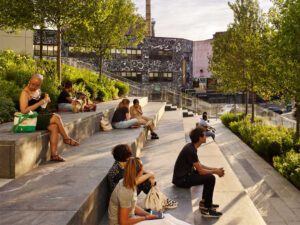
BAM South Site – 300 Ashland, TEN Arquitectos
2. Destination by Mixing Uses – People are often drawn to places where other people congregate and given the trend towards experiential design, the mix of uses should be synergistic to enhance the overall experience. Great open space destinations are often unique places where people can form positive memories and personal connections with the place itself. Think back to your favorite places—many appealed to multiple senses allowing connections and memories to be more vivid. The architecture or landscape may have been unique, and the sounds and smells were distinctive and inviting. There may have been interactive pieces to the place, and the food was delicious. The more senses a place can positively influence the greater possibility of becoming a well-loved destination. For this reason, adding supportive and synergistic uses can increase the functionality and form of the space.Keep in mind that mixing uses for the sake of creating a destination is not enough. Imagine a big box store and gas station in the middle of a regional park. Those types of uses undermine the setting and use of the park. Open spaces and other uses must be integrated and designed in tandem with what makes the site or area unique, and the mixing of uses should play to those unique characteristics.Below are a few examples of destination by mixing uses:
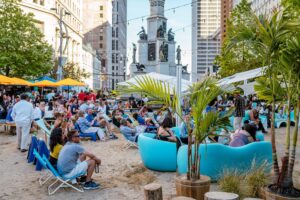
- Context and Experiential Design Driven Placemaking – Placelessness can be found in open spaces across the United States. The token park is an open field with a few scattered trees, a pavilion, a play structure or two, and potentially a looping trail around the perimeter. Visit these parks and you will see a handful of people at most. The reason for this is because there is nothing unique or exciting about the park. On the other hand, parks that focus too much on form/design and not enough on function have the same result. These types of designs have plagued our neighborhoods and cities far too long. I am not proposing that more money needs to be spent on open spaces or even that every park needs to have some specific theme. What I am proposing is that every open space should be thoughtfully designed (form and function) and focused on adapting to the needs of its surrounding neighborhoods and communities.How can we design our open spaces to have a sense of place and still account for post-COVID-19 concerns? For starters, forget the notion that every park needs a play structure, looping trail, large field, and a pavilion because they do not. A simple observation of a generic placeless park or form/design emphasized park versus one that is unique and designed for people would show that the latter is well used, and the former is not. After you let go of the preconceived ideas for the park consider the following:
- What does the community want, and what is their vision?
- People and place should be first and design second.
- How will individuals access and interact with the park?
- The problem is not money it is creativity.
- How will it integrate with the community?
- Do not be afraid to implement areas for tactical urbanism.
- What does the community want, and what is their vision?
Here are a few examples of placemaking through context and experiential design: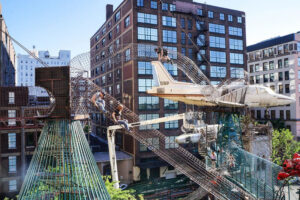
- Accessible for All – It has become more common place for playground design to incorporate all abilities, but this is far from the norm for all open space types. Although all abilities should be incorporated into every open space design it can be difficult to mentally experience what those with varying abilities experience. When accessibility for all comes to mind this is often one of the first considerations thought of, but this tip is intended to encompass more than just varying abilities. Considerations for circulation (including desire lines), multimodal access, and access for all abilities should be incorporated.Some of the best advice I have ever received regarding this topic is to go through the space as if you were that person. The advice is simple yet highly effective. There is power to the proverbial quote, “You can’t understand someone until you’ve walked a mile in their shoes.” So, wheel, bike, and walk, yourself around to gain a better understanding.Below are a few examples of accessibility for all:
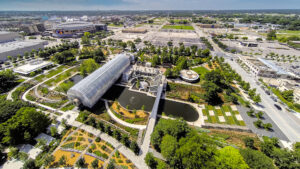
Myriad Botanical Gardens
- Integrate Technology – Integrating technology into public open spaces can be difficult due to cost and the speed at which technology is progressing. It is essential in transitioning our open spaces to more environmentally/pandemic-friendly and socially/culturally relevant environments. One of the essential integrations given the current pandemic is that of touchless technology (i.e. touchless water fountains, sinks, hand dryers, elevators, pedestrian crossings, parking meters, doors, lights, and so on), which allows users of all abilities to interact with their surroundings without ever having to touch a thing. A second environmental/fiscal essential integration is that of resource reducing technologies like smart irrigation controllers, and energy-generating structures and lighting. These technologies can reduce ongoing maintenance and resource costs making the transition to their use more affordable.The social/cultural side of integrating technology is finding a proper balance between integrating new and emerging technologies with the desire and need for biophilic open space designs. Some of these integrated technologies include digital wayfinding signs, interactive play structures and floor projectors, visitor and user data tracking, real time info, adaptive lighting, educational installments, micromobility options, active/passive lighting and heating, and public Wi-Fi. These technologies help our open spaces appeal to a new generation while continuing to perform their necessary functions.
A few examples of integrated technology: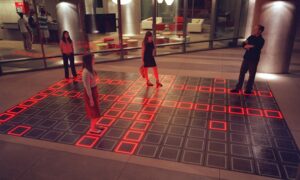
- Design for the Elements – Something that has been relatively unchanged since the beginning of open space design is weather—and yet rarely do our modern open spaces account for it. The changes in seasons come every year and many of our open spaces sit dormant for the periods which the open space design did not consider. These periods could be intense heat, cold, snow, wind, rain, or other inclement weather. Our culture has even grown to avoid leaving our houses during these weather periods, because there is little to nothing to protect us or help us embrace these times.It is well-documented that open spaces improve the health of residents, but if residents are not able to use these open spaces that health benefit is diminished. So, what can be done to reverse this cultural shift? Integrate the elements back into our open spaces.Below are a few examples of open spaces integrating the elements:
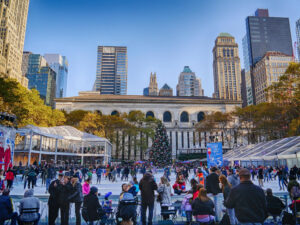
- Never Finish – This last tip refers to delivering a project that can adapt and change. An open space that can change and adapt is an open space that will continue to be relevant. Leaving areas open, incorporating technology, implementing tactical urbanism, and allowing spaces to be flexible will allow your open space to grow and adapt with its surroundings. We live in a constantly evolving world. It’s time that our open spaces evolved with us. Other open space examples not shown above:
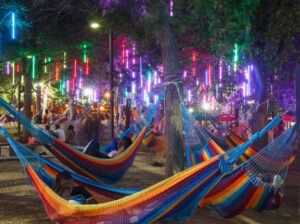
- Spruce Street Harbor Park
- Hosier Lane
- Penguin Park
- Container Park
- Levy Park
- Park Guell
- High Line
- Domino Park
- Darling Quarter
- South LA Wetland Park (Psomas)
Reach out to us for more information regarding our services or a free project quote! Chris can be reached at 801.284.1362 or [email protected].